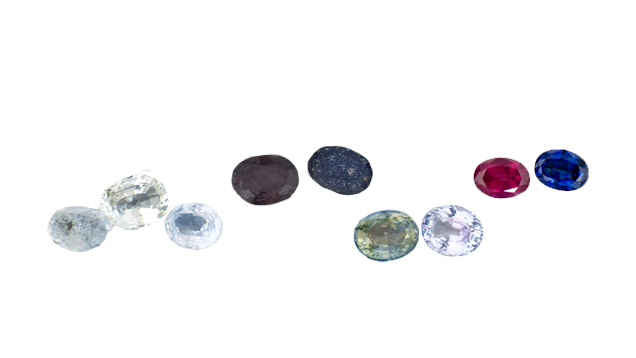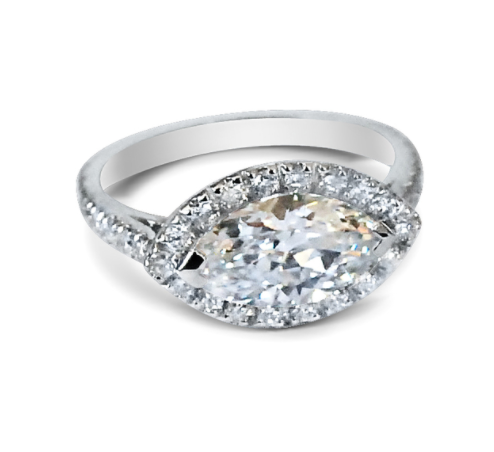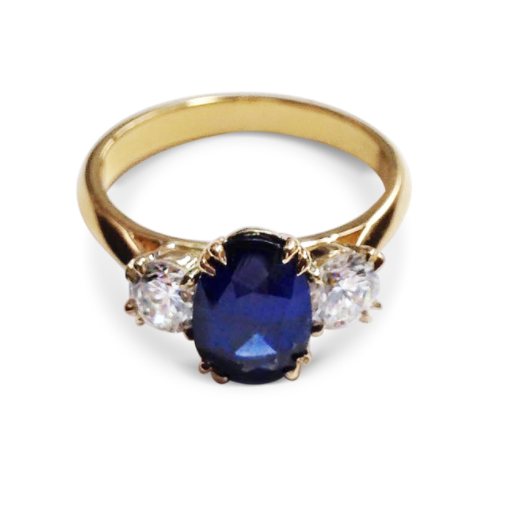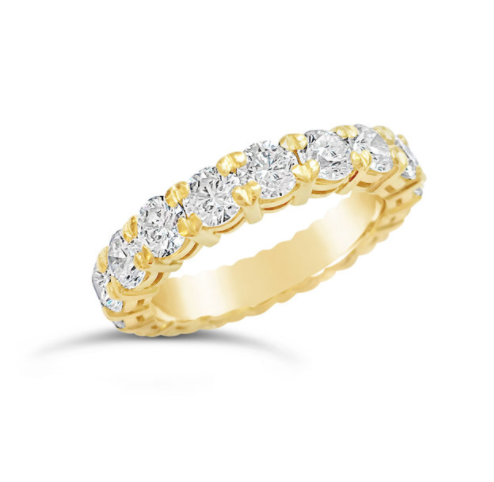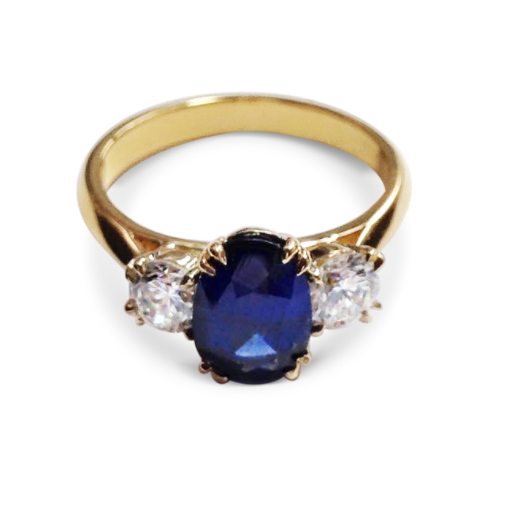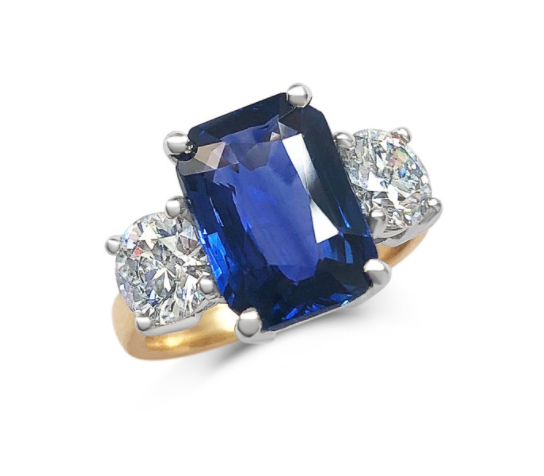GLOSSARY
A guide through the vast world of gemstones and fine jewellery.
If you’d like to know more about any of the jewellery terms we talk about here or if anything sparks an idea for a bespoke commission, please contact us.
STONE CUTS / SHAPES
A brilliant-cut diamond indicates exactly 58 facets to allow maximum light refelction, and characterised by a round outline.
Old-cut diamonds are antique and have been cut without the precision of modern technology.
The princess-cut is a straight sided square or rectangle outline with faceting for optimal light refraction.
Baguette cut stones are small, usually rectangular, step-cut diamonds with straight or tapered edges.
The Asscher cut is similar to an emerald cut, the Asscher cut's 58 facets are larger and wide-set.
A trapeze-cut diamond has four sides, with the bottom sides parallel to each other and the other sides inclined inwards.
The Trillion cut diamond features 50 facets and a triangular shape comprised of three equal sides.
The kite-cut diamond features an elongated diamond with the two top sides inclined inwards meeting at the top point with the two even longer sides meeting up at the endpoint.
The single cut diamond is also known as the eight-cut diamond because it has eight facets on the table and eight facets on the pavilion.
The old European cut was an early evolutionary stage in the progression toward the modern round brilliant.
Rose Cut Diamonds are different than the traditional 'Brilliant Cut' diamond we know in this modern era.
Half moon diamonds are cut straight on one side and curved on the other side; they are essentially an oval diamond cut in half.
Gemstone Type
Emerald is the green to greenish blue variety of beryl, a mineral species that also includes aquamarine as well as beryls in other colours.
The name “sapphire” belongs to the mineral species corundum that’s not red and doesn’t qualify as ruby.
Ruby is the most valuable variety of the corundum mineral species, which also includes sapphire.
Perhaps the best-loved gems of all time, pearls—both natural and modern cultured pearls—occur in a wide variety of colours.
Garnets are a set of closely related minerals that form a group, resulting in gemstones in almost every colour.
Tourmalines have one of the widest colour ranges of any gem species, occurring in various shades of virtually every hue.
Two different gem materials can correctly be called jade. Jadeite is one of them, and the other is nephrite. Both are actually metamorphic rocks made up of tiny interlocking mineral crystals.
Lemon quartz is created by heating amethyst, yellow quartz and iron together at extremely high temperatures.
Spinel, like garnet and diamond, is singly refractive, with the same physical properties in all crystal directions.
Topaz is allochromatic, which means that its colour is caused by impurity elements or defects in its crystal structure rather than by an element of its basic chemical composition.
Citrine - the transparent, pale yellow to brownish orange variety of quartz - is rare in nature. In the days before modern gemmology, its tawny colour caused it to be confused with topaz.
Peridot is the gem variety of the mineral olivine. Its chemical composition includes iron and magnesium, and iron is the cause of its attractive yellowish green colours.
Star sapphire is a rare and unique variety of the natural Sapphire gemstone that displays a star-like effect (asterism) on the surface when viewed under a direct light source.
Star ruby is a rare variety of ruby gemstone that contains dense, microscopic rutile inclusions.
Fancy Coloured Diamonds
Pink diamonds contain graining lines within their atomic structure caused by pressure beneath the Earth’s surface.
Blue diamonds represent only 0.1% of all natural fancy coloured diamonds, making them extremely rare and valuable.
Green diamonds are typically light in town and low in saturation. Their colour often appears muted, with a greyish or brownish cast.
Ranging from pale translucent saffron to fiery autumnal hues, natural fancy orange diamonds are predominantly found in South Africa.
Natural red fancy colour diamonds are the rarest of the coloured diamond collection and are highly valued.
Brown is the most common natural fancy colour diamond and also the earliest to be used in jewellery.
Black diamonds differ from other fancy coloured diamonds, as these coloured diamonds are usually formed by chemical impurities present during the diamond’s composition.
Salt and Pepper diamonds are highly included. Salt-and-pepper diamonds is a diamond with inclusions that appear black and white.
The 4 C’s
Clarity is a measure of the purity and rarity of the diamond, graded by the visibility of these characteristics under 10-power magnification.
Carat refers to the weight of a diamond, not the size, because carat weight can be deceptive.
MOH’S SCALE
Moh’s hardness, rough measure of the resistance of a smooth surface to scratching or abrasion, expressed in terms of a scale devised (1812) by the German mineralogist Friedrich Moh’s.
Handmade Vs Cast
Handmade jewellery involves working with metal from scratch using a very high level of craftsmanship.
Lab Grown, Synthetic & Diamond Simulants
Lab Grown/synthetic diamonds are created in a laboratory or factory rather than occurring in nature and mined from the earth.
Metal Type
The gold content also known as fineness is a measure of a precious metal’s purity, and it’s based on parts per thousand (ppt).
Yellow gold is naturally yellow in colour. However, as pure gold is very soft it is usually mixed with alloy metals such as copper and zinc.
White gold is made by alloying pure gold with white metals such as nickel, silver and palladium. Usually with a rhodium coating.
Platinum is usually mixed with other similar metals such a palladium group metals (palladium, iridium, ruthenium, rhodium and osmium).
Silver is made by alloying pure silver with copper to make it stronger usually known as sterling silver.
9ct gold is 37.5% pure gold with 62.5% alloying metals. When stamped or hallmarked you will see 9KT or 375.
Enamel in jewellery and decorative work goes by a few names—vitreous enamel, porcelain enamel, and painted glass.
ERAs
Lab Grown/synthetic diamonds are created in a laboratory or factory rather than occurring in nature and mined from the earth.
Victorian era (1837 to 1901): Yellow gold engagement rings and rose gold engagement rings were popular during the Victorian era.
Art Nouveau Era (1890-1914): French for “new art,” Art Nouveau was a radical departure from historic revival styles.
Edwardian era (1900 to 1915): Platinum was typically used in Edwardian era engagement rings.
Art Deco era (1920s and 1930s): We think of Art Deco as cool and sophisticated, so it’s no wonder that white metal was popular during this period.
Retro era (1940s): Warmth, boldness and colour were signatures of this period. These designs had a sculptural quality that featured bold lines and geometric shapes softened with curves.
Birthstones
Those born in January are lucky to have the beautiful and diverse garnet as their birthstone.
If you were born in February, your birthstone is amethyst – the purple variety of quartz that has captivated mankind for millennia.
Aquamarine and bloodstone, March’s two birthstones, are very different when it comes to appearance, but they share a similar reputation for protecting one’s well-being.
Those born in April are lucky enough to call this scintillating gem, a symbol of clarity and strength, their birthstone.
Emerald, the birthstone for May, has been beloved for millennia, evoking rebirth and renewal.
If you were born in the month of June, you are lucky enough to have three birthstones to call your own.
The September birthstone is sapphire – a gem that’s been cherished for thousands of years.
Those born in October enjoy two spectacular birthstones to commemorate their birthdays – opal and tourmaline.
Those with November birthdays have two beautiful birthstones to choose from: topaz and citrine.
If you had to pick one December birthstone, which would it be: tanzanite, turquoise or zircon?
Coloured Stone Treatments
Lab Grown/synthetic diamonds are created in a laboratory or factory rather than occurring in nature and mined from the earth.
The exposure of a gem to high temperatures for the purpose of altering its colour and/or clarity.
A chemical used to alter / reduce a component of, or the entire colour, of a porous gem. Some gemstones are bleached and then dyed, a form of “combination treatment.”
Altering a gem’s appearance by applying a colouring agent like paint to the back surfaces of gems (a treatment known as “backing”), or paint applied as a coating to all or a portion of a gemstone’s surface with the effect of altering the colour.
Filling surface-reaching fractures or cavities with a glass, resin, wax or oil to conceal their visibility and to improve the apparent clarity of gem materials, appearance, stability, or in extreme cases—to add to a slight amount of weight to a gem.
Heating a diamond to high temperatures under high confining pressures to remove, or change its colour.
The surface of a porous gemstone is permeated with a polymer, wax or plastic to give it greater durability and improve its appearance.
This involves using a narrow focused beam of laser light to burn an open channel from the surface of a diamond to reach dark inclusions.
The penetration of certain elements into the atomic lattice of a gemstone during heat treatment, with the objective of changing or accentuating its colour.
Fluorescence
Fluorescence is the visible light some diamonds emit when they are exposed to invisible ultraviolet (UV) rays.
RING TYPES
Lab Grown/synthetic diamonds are created in a laboratory or factory rather than occurring in nature and mined from the earth.
In a cluster setting, smaller diamonds are set closely together to resemble a larger diamond. A cluster ring can contain a large center stone or a group of stones of equal size.
An Etruscan style ring is inspired by the ancient jewellery of Etruscan civilizations predating the Romans.
A simple band set with a continuous line of identically cut gemstones. Traditional symbolism of eternity rings alludes to never-ending love for the wearer.
A ring design with an oversized rounded and curving form, a style made popular in the Edwardian era and influenced trends of the 1950-1970's.
A ring setting that encircles a gemstone with a single halo of smaller stones. A popular choice to visually increase the size of a center stone.
A crimped/gathered collet setting which was often cut down between the crimped/gathered metal sections to create claw/prong-like protrusions;
A style developed in the Edwardian era with a distintive appearance of concentic radiating rows of gemstones from a principle center stone.
A Victorian era design, with typically 1-5 recessed stones where the surface of the mount is virtually flush with the top of the gemstone. Oringinally a token of friendship, made popular today as a hardwearing option for setting gemstones.
The carved half hoop ring style was exceedingly popular and fashionable during the Victorian era.
SETTINGS
Channel setting is a distinctive look created when accent stones are set into a grooved channel and laid edge-to-edge in a row. This design protects the gemstones, making this setting style ideal for daily wear.
Minimal setting where a gemstone is held in the tension between two pieces of metal. Gemstone appears to float with optimal light access. This setting is the least secure and will need proper attention when wearing.
Pavé settings typically include multiple rows of interlocking stones, originating from the word pavement in French.
Micro setting refers to a microscopic distance between stones, using small stones to give the illusion of a fully gem-studded and even surface.
A technique used to cover metal with small gemstones. Small prongs, or "beads" are used to keep stones in place along the band or surface.
Typically 3-6 prongs secure the stone, depending on the size of the gemstone. The prongs can vary in thickness for security and this setting exposes the gemstone to a large amount of light.
A rim of metal encapsulates the stone, providing the utmost level of security. Gemstones are protected from accidental damage as this setting is the most hard-wearing.
CLAW TYPES
Lab Grown/synthetic diamonds are created in a laboratory or factory rather than occurring in nature and mined from the earth.
Ring Size Chart
To determine your size, we strongly advise that you measure the size of your finger rather than the size of your ring.
Ultrasonic Cleaner
Lab Grown/synthetic diamonds are created in a laboratory or factory rather than occurring in nature and mined from the earth.





































































































